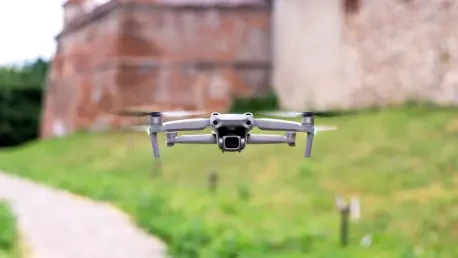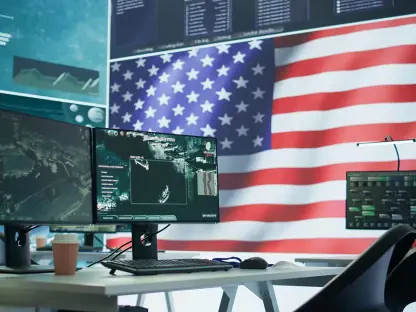In an era where unmanned aircraft systems, commonly known as drones, are becoming ubiquitous, a staggering statistic emerges: over one million drones are currently registered with the Federal Aviation Administration (FAA), with projections estimating a tripling of that number by 2028. This rapid proliferation poses unprecedented challenges to national security, public safety, and critical infrastructure like airports and borders. As key counter-drone authorities granted to the Department of Homeland Security (DHS) and the Department of Justice (DOJ) face expiration on September 29, 2025, the urgency to act has never been greater. This roundup gathers insights from various experts, policymakers, and industry stakeholders to explore the multifaceted risks of drones, the consequences of legislative inaction, and the pressing need for robust protections to safeguard American skies.
Diverse Perspectives on the Drone Threat Landscape
Rising Concerns Over Unmanned Aircraft Risks
Industry analysts have repeatedly sounded the alarm on the escalating dangers posed by drones, particularly in civilian airspace. Reports of near-miss incidents at major U.S. airports have surged, with some studies indicating that drones account for nearly two-thirds of such encounters at the busiest hubs this year. These incidents underscore a growing consensus that unregulated drone activity could lead to catastrophic collisions with commercial aircraft, endangering countless lives.
Security specialists highlight another dimension of the threat, pointing to the criminal exploitation of drones. At the U.S. border, for instance, military officials have noted thousands of monthly drone incursions linked to cartel operations, often used to smuggle narcotics. This alarming trend reveals how accessible technology can be weaponized by illicit networks, amplifying risks to national safety if countermeasures are not sustained.
A point of contention among stakeholders is the balance between civilian freedoms and security imperatives. While hobbyists and commercial operators argue for fewer restrictions to foster innovation, law enforcement advocates stress that without strict oversight, the potential for misuse grows exponentially. This polarized debate complicates the path toward effective regulation.
Vulnerabilities in Critical Infrastructure
Aviation experts have zeroed in on the acute risks drones pose to critical sectors, especially air travel. Instances such as a drone coming within 50 feet of a passenger jet in Newark earlier this year, or another striking a firefighting aircraft during a wildfire response in Los Angeles, illustrate the tangible dangers. These events are not isolated but part of a broader pattern of disruption.
Infrastructure protection agencies emphasize that the economic fallout from such incidents could be staggering. A single drone-related accident at a major airport could halt operations, costing millions in delays and damages while eroding public confidence in air travel safety. The ripple effects on supply chains and emergency response capabilities are equally concerning, as highlighted by recent analyses.
Some voices in the policy sphere caution against overregulation, warning that heavy-handed measures might stifle legitimate drone applications in agriculture, delivery services, and disaster relief. Finding a middle ground that protects vital systems without hampering progress remains a key challenge for lawmakers grappling with this issue.
Drones in Global Conflict and Espionage
Military strategists have drawn attention to the role of drones in international warfare and espionage, citing their widespread use in conflicts across Ukraine and the Middle East. These small, agile devices have become tools for both state and non-state actors, capable of delivering lethal payloads or gathering sensitive intelligence with minimal detection.
Geopolitical analysts warn of the potential for adversaries to exploit gaps in U.S. drone defenses, especially if counter-drone authorities lapse. Recent reports of suspicious drone activity over European airspace, potentially linked to hostile nations, serve as a stark reminder that domestic vulnerabilities could invite foreign interference or surveillance on American soil.
There is broad agreement among defense experts that drone technology is evolving faster than regulatory frameworks can adapt. This asymmetry creates windows of opportunity for malicious actors, prompting calls for proactive measures to counter not just current threats but also those anticipated in the coming years through 2027 and beyond.
State of Counter-Drone Policies and Challenges
Legal scholars note that the counter-drone (C-UAS) authorities, first established in 2018, represent a carefully negotiated framework involving federal, state, and private entities. These powers have enabled the detection and mitigation of rogue drones, but their impending expiration raises questions about the nation’s readiness to handle emerging risks without a solid legal backbone.
Policy advisors point out a glimmer of hope in recent bipartisan efforts within the House to enhance C-UAS capabilities and expand state and local roles in drone interdiction. However, the looming threat of a government shutdown could stall these initiatives, leaving critical protections in limbo at a pivotal moment.
A recurring concern among security consultants is the lack of public awareness about the stakes involved. Many argue that without a unified push from both government and civic sectors to prioritize this issue, the momentum for legislative renewal could falter, exposing the nation to preventable yet severe consequences.
Key Takeaways and Path Forward
Reflecting on the insights gathered, it becomes clear that the drone threat is a complex, multifaceted challenge demanding immediate attention. Experts across aviation, security, and defense sectors agree that the rapid proliferation of unmanned systems poses significant risks to public safety, critical infrastructure, and national defense. Differing views on regulation versus innovation highlight the delicate balance policymakers must strike.
Looking ahead, actionable steps emerge as vital for progress. Stakeholders advocate for the urgent renewal of C-UAS authorities by Congress to prevent any lapse in protections. Expanding state and local involvement in drone detection is seen as a practical solution to bolster national efforts. Additionally, raising public awareness about drone risks and supporting bipartisan legislative initiatives are identified as crucial moves to ensure security takes precedence over political gridlock.
For those seeking a deeper understanding, exploring further resources on drone technology trends and legislative updates offers a way to stay informed. Engaging in policy discussions and advocating for balanced, forward-thinking regulations remain essential steps to safeguard America’s skies against evolving threats.









